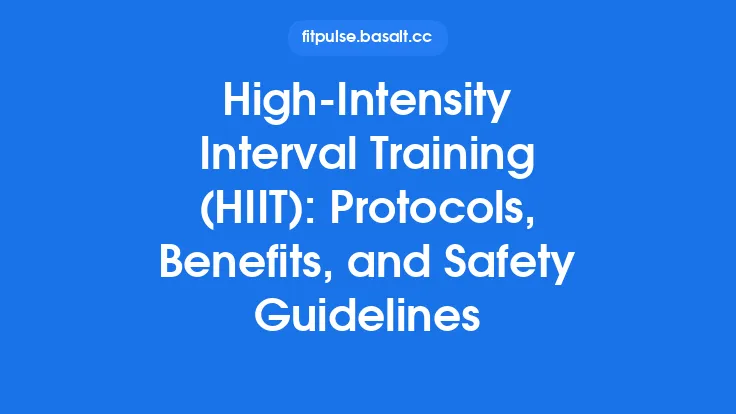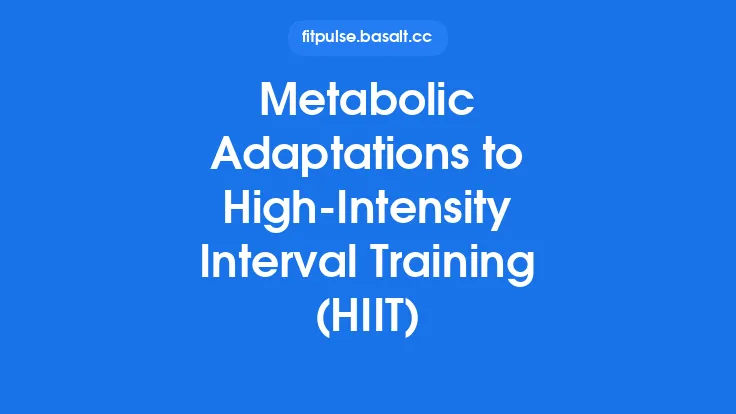High‑Intensity Interval Training (HIIT) has become a household name in fitness circles, yet many people still wonder what truly happens inside the body when you push hard for a short burst and then recover. Understanding the science behind HIIT not only demystifies its reputation as a “quick‑fix” for fitness, it also equips you to make informed decisions about how to incorporate it safely and effectively into your routine. Below, we explore the physiological, metabolic, and molecular mechanisms that make HIIT a powerful stimulus for cardiovascular conditioning and overall health.
The Physiological Foundations of HIIT
At its core, HIIT is a form of exercise that alternates brief periods of maximal or near‑maximal effort with recovery intervals of lower intensity or complete rest. This pattern creates a unique stress‑recovery cycle that differs markedly from steady‑state cardio. The rapid shifts in intensity trigger acute responses in the heart, lungs, and muscles, while the repeated exposure over weeks drives chronic adaptations. Two overarching principles govern these responses:
- Intensity‑Driven Recruitment – The high‑intensity bouts demand rapid, forceful muscle contractions, which recruit a larger proportion of motor units, including the fast‑twitch (type II) fibers that are less engaged during moderate‑intensity work.
- Recovery‑Driven Metabolic Challenge – The low‑intensity or rest phases do not allow the body to fully return to baseline, forcing it to continue metabolizing substrates and clearing metabolic by‑products. This sustained demand fuels post‑exercise oxygen consumption and stimulates adaptive signaling pathways.
Energy System Contributions: From Phosphagen to Oxidative Pathways
HIIT’s brief, explosive efforts rely heavily on the phosphagen (ATP‑PCr) system, which provides immediate energy for up to ~10 seconds of maximal effort. As the interval extends beyond this window, the anaerobic glycolytic pathway steps in, breaking down muscle glycogen to produce ATP quickly, albeit with lactate as a by‑product.
During the recovery periods, the body shifts toward the oxidative (aerobic) system to replenish depleted phosphocreatine stores, clear lactate, and restore homeostasis. This oscillation between energy systems forces the cardiovascular and respiratory systems to operate at varying intensities, promoting a broader range of adaptations than a single, steady‑state modality.
Cellular Adaptations: Mitochondria, Enzymes, and Hormonal Responses
Repeated HIIT sessions stimulate several key cellular changes:
- Mitochondrial Biogenesis – The repeated demand for rapid ATP production upregulates peroxisome proliferator‑activated receptor gamma coactivator‑1α (PGC‑1α), a master regulator of mitochondrial creation. More mitochondria translate to greater oxidative capacity and improved endurance.
- Enzymatic Upregulation – Activities of oxidative enzymes such as citrate synthase and β‑hydroxyacyl‑CoA dehydrogenase increase, enhancing the muscle’s ability to oxidize fats and carbohydrates.
- Hormonal Shifts – Acute bouts raise circulating catecholamines (epinephrine, norepinephrine) and growth hormone, which together promote lipolysis and protein synthesis. Over time, basal levels of insulin sensitivity improve, supporting better glucose regulation.
Cardiovascular Benefits: Stroke Volume, VO₂ max, and Endothelial Function
HIIT’s high‑intensity spikes place a substantial load on the heart, prompting several cardiovascular adaptations:
- Increased Stroke Volume – The heart learns to pump more blood per beat, reducing the need for a high heart rate to meet oxygen demands.
- Elevated VO₂ max – Maximal oxygen uptake, a gold‑standard measure of aerobic fitness, improves markedly after several weeks of HIIT, often comparable to traditional endurance training but in less total time.
- Enhanced Endothelial Function – Shear stress from rapid blood flow during intense intervals stimulates nitric oxide production, improving arterial elasticity and reducing blood pressure.
Metabolic Implications: EPOC, Fat Oxidation, and Insulin Sensitivity
One of HIIT’s most celebrated effects is the excess post‑exercise oxygen consumption (EPOC), sometimes called the “afterburn.” After a HIIT session, the body continues to consume oxygen at an elevated rate for 30 minutes to several hours, depending on the workout’s intensity and duration. This prolonged oxygen demand drives:
- Increased Caloric Expenditure – Even after the workout ends, the body burns additional calories, contributing to energy balance.
- Enhanced Fat Oxidation – The sustained metabolic demand encourages the mobilization and oxidation of fatty acids, supporting body composition goals.
- Improved Insulin Sensitivity – Repeated high‑intensity bouts improve the muscle’s ability to uptake glucose in response to insulin, a protective factor against type 2 diabetes.
Neuromuscular Effects: Motor Unit Recruitment and Muscle Fiber Plasticity
HIIT’s rapid, forceful contractions recruit a high proportion of type II (fast‑twitch) motor units, which are typically under‑utilized in moderate‑intensity cardio. Over time, this recruitment leads to:
- Increased Motor Unit Firing Frequency – The nervous system becomes more efficient at activating muscle fibers quickly.
- Fiber Type Shifts – Some type IIa fibers (fast‑oxidative) may adopt more oxidative characteristics, blending strength and endurance qualities.
- Improved Power Output – Even without heavy resistance training, HIIT can boost muscular power, benefiting activities that require quick bursts of effort.
Hormonal and Molecular Signaling: AMPK, PGC‑1α, and Myokines
Beyond the immediate catecholamine surge, HIIT activates several intracellular signaling pathways:
- AMP‑Activated Protein Kinase (AMPK) – Senses cellular energy deficits and stimulates glucose uptake, fatty acid oxidation, and mitochondrial biogenesis.
- PGC‑1α (again) – Works downstream of AMPK to orchestrate mitochondrial growth and oxidative enzyme expression.
- Myokines (e.g., IL‑6, irisin) – Contracting muscle releases cytokine‑like proteins that exert systemic effects, including anti‑inflammatory actions and browning of white adipose tissue.
These molecular messengers help explain why HIIT can confer health benefits that extend beyond the muscles directly involved in the workout.
Age‑Related Considerations and Longevity Impacts
Research indicates that HIIT can be particularly advantageous for older adults:
- Preservation of Muscle Mass – The high‑intensity stimulus helps counteract age‑related sarcopenia.
- Cardiovascular Health – Improvements in arterial stiffness and VO₂ max are observed even in populations over 65, reducing the risk of cardiovascular disease.
- Cognitive Benefits – Acute HIIT sessions increase brain‑derived neurotrophic factor (BDNF), supporting neuroplasticity and potentially mitigating age‑related cognitive decline.
Because HIIT delivers robust adaptations in a time‑efficient package, it aligns well with the lifestyle constraints often faced by older individuals.
Safety and Contraindications: Who Should Approach HIIT Cautiously
While HIIT is generally safe for healthy individuals, certain groups should proceed with caution or seek professional guidance:
- Cardiovascular Disease – Those with uncontrolled hypertension, recent myocardial infarction, or severe arrhythmias should obtain medical clearance.
- Joint or Musculoskeletal Issues – High‑impact movements can exacerbate joint pain; low‑impact alternatives or modified intensities may be necessary.
- Pregnancy – Intense intervals may not be advisable for all trimesters; a tailored program under obstetric supervision is recommended.
- Novice Exercisers – Beginners should first establish a baseline of aerobic fitness before attempting maximal efforts, to reduce injury risk.
A gradual introduction—starting with shorter intervals at a moderate intensity—allows the body to adapt safely.
Practical Tips for Implementing HIIT Safely
Even without prescribing specific interval structures, the following guidelines help ensure a beneficial HIIT experience:
- Prioritize Proper Technique – Quality of movement supersedes speed; maintain good form throughout each burst.
- Monitor Intensity Subjectively – Use perceived exertion (e.g., a 1‑10 scale) to gauge effort; aim for a “hard” to “very hard” level during work phases.
- Stay Hydrated and Fuel Appropriately – Adequate carbohydrate availability supports high‑intensity performance, while hydration aids recovery.
- Allow Sufficient Recovery Between Sessions – Because HIIT imposes a high neuromuscular load, spacing sessions (e.g., 48‑72 hours) helps prevent overreaching.
- Incorporate Variety – Rotate between different movement patterns (e.g., cycling, rowing, sprinting) to reduce repetitive stress on any single joint or muscle group.
- Listen to Your Body – Persistent fatigue, excessive soreness, or unusual pain are signals to reduce intensity or increase rest.
Frequently Asked Questions About HIIT Science
Q: Does HIIT improve endurance as well as strength?
A: Yes. By challenging both the aerobic and anaerobic systems, HIIT enhances VO₂ max (endurance) while also recruiting fast‑twitch fibers (strength/power).
Q: How long does it take to see physiological changes?
A: Early improvements in VO₂ max and insulin sensitivity can appear after 2‑4 weeks of consistent HIIT, while mitochondrial adaptations may become evident after 6‑8 weeks.
Q: Is the “afterburn” effect significant for weight loss?
A: EPOC contributes additional calorie burn, but it represents a modest portion of total energy expenditure. Long‑term weight management still relies on overall energy balance.
Q: Can HIIT be combined with other training modalities?
A: Absolutely. HIIT complements resistance training, flexibility work, and low‑intensity steady‑state cardio, creating a well‑rounded fitness program.
Q: Why does HIIT feel so uncomfortable?
A: The high intensity pushes the body toward its physiological limits, leading to rapid lactate accumulation, elevated heart rate, and heightened perception of effort. This discomfort is a sign that the stimulus is strong enough to drive adaptation.
By delving into the underlying science, we see that HIIT is far more than a trendy time‑saver. Its ability to simultaneously tax multiple energy systems, stimulate profound cellular signaling, and elicit robust cardiovascular and metabolic adaptations makes it a uniquely efficient tool for improving health and performance. Armed with this knowledge, you can approach high‑intensity interval training with confidence, tailoring it to your goals while respecting the body’s need for recovery and safety.





